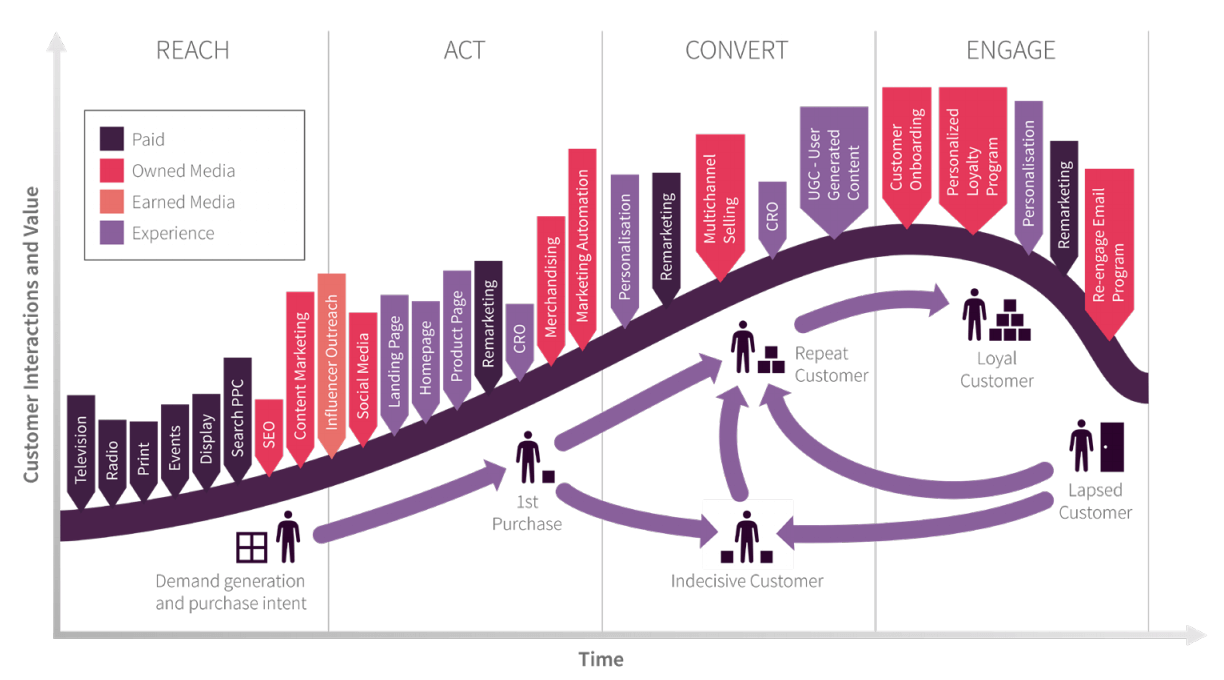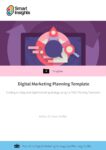Why use a framework to create an integrated marketing strategy?
I believe that implementing a digital marketing strategy framework to follow is essential to ensure the success of your integrated marketing strategy. Importantly by agreeing on a marketing plan structure during the planning phase, you can ensure the buy-in from your team and business to support your integrated marketing strategy.
Applying a strategic framework creates a system to make your plans easier to understand and gives a way to assign specific metrics to monitor, manage and measure the performance of your integrated marketing strategy.
The RACE Framework
We've created the RACE Framework and subsequent RACE marketing training to empower marketing leaders to take a data-driven, customer-centric approach to planning, managing, and optimizing their marketing strategies. By using this structure for your planning, you can integrate all your marketing activities across your key omnichannel customer touchpoints, to strengthen your reach, interaction, conversion, and engagement.

Smart Insights membership gives you a set of tried and tested online training courses, and marketing tools, integrated across the RACE Framework, to help you accelerate your performance and grow your business. Download our Free digital marketing plan template to get started today.
Free digital marketing plan template
Our popular marketing planning template is structured across the Smart Insights RACE Framework. Join Smart Insights as a Free Member to download our digital marketing plan template today
Access the Digital marketing plan template
Section 1: Organization Health Check
There are 4 key areas to focus on: customer, business, internal and external contexts:
1. Customer context
This is defined by highlighting specific segments of customers who interact with your business whether through acquisition or communication; What the level of awareness, perception, and attitude is of your target customer base e.g. is your business benefiting from a growing reputation (e.g. growth in brand search, are your social media metrics providing a positive sentiment? Has email database been increasing in sign-ups?)
It's also important to think about the external business environment you operate in and the types of perceived risk which are encountered. e.g. What is the level of competition your business operates in within this sector? Are there a number of competitors and what are they doing to attract market share (and more importantly your customer base?).
2. Business Context
What is your corporate and marketing strategy? In other words, how do you differentiate your business from the competition? Evaluating your brand positioning will also provide you with an external view of how your business is perceived by customers.
Importantly, how are you perceived by your suppliers? And are you a trustworthy organization to partner with? Think about any existing partnerships that are in operation?
Organisation Identity: If you are an online retailer, it benefits from commanding a strong domain name, use tools such as SEOmoz software, which can provide you with an insight into the value or trust-worthiness of your website online.
3. External context
As highlighted earlier, think about your external environment and list out who your key stakeholders are such as your consumers (look to create a persona on the types of consumers you attract); media (what media channels is your brand available through or can offer interaction with the end-user?) affiliates (do you provide alternative routes for your product offering, brand to interact with customers?).
Other tools which can provide a good evaluation to your business within an external environment are a SWOT and PEST analysis.
4. Internal context
As you have completed with the external context, look to critically evaluate the business with an internal focus. Key indicators and questions worth considering and recording are:
- Financial constraints: any you need to be aware of e.g. If you are looking to create a new product marketing strategy for a new range of footwear, what, realistically is the marketing budget available, and are you being realistic with your overall strategy?
- Culture, values and beliefs: has the business created excellence in customer service for example or despatch and delivery of products?
- Marketing expertise: do you have the necessary skill set, staff, and resources to support your framework in your organization?
Section 2: Integrated marketing strategy barriers and opportunities
So from completing your context analysis, a series of issues, barriers, and opportunities should now have been identified and documented. Below are some suggested barriers and opportunities you may consider if you are creating an integrated marketing strategy for an online retailer:
- Retail Competitors: level of competition within the marketplace, identify and list out each competitor and their USP's level of differentiation from your offering.
- Brands Influence: level of influence your brand has - what domain level of trust? % of brand/non-brand search terms a month? Relationship your brand has with your direct product suppliers, customers (repeat purchase rates?)
- Price Influenced. within the current economic climate, understand how your and what your level of price-point is should be considered - where does your business sit?
- Strategic Partnerships: has your business developed a level of partnerships with other strategic clients? Have you managed to create an affiliate marketing strategy and is your online proposition encouraging affiliates to buy in to your vision to sell your products?
Section 3: Your integrated marketing strategy communications objectives
Outlining your barriers and opportunities will help form what your objectives will be for the report. To do this it is important to create SMART objectives which refer to: Specific, Measurable, Achievable, Realistic, and Time-specific.
Below are a few examples based on a campaign with the objective to increase brand alignment for a product launch and has a secondary objective of sales:
- Objective 1 Brand: increase brand visibility in the UK market within the age bracket of 18-35 by 20% for Product X from April 2013 through to June 2013 and measured through Google analytics.
- Objective 2 Sales: achieve a 10% increase in sales of Product X based on previous year (April – June 2012).
Both objectives should have measurement criteria in place to assess how both objectives will be met.
Section 4: Creative idea
The creative idea should be developed taking into account consideration of what your objectives are. This should also help to provide an insight into how your creative idea can differentiate your campaign from the competition, so look to reference your findings from the first section too.
The creative element is a brief overview of "what you plan to do and to create a storyboard or guide on how you plan to meet your objectives?".
Look to:
- include a Headline offer and supporting campaign/promotion too.
- bring this section to life by including a visual of the idea or product launch and look to embed a strapline for the campaign which can be crucial to ensure the promotion stands out during the campaign. It acts as a sign-post to potential new and existing customers.
- justify your creative idea.
Section 5: Your integrated marketing engagement strategy
This section should provide an overview of the specific tactics to be used, justifications, audience profile, and how this is all to be managed, measured, and monitored:
- Target audience and justification. What market research has been recorded and analysed for this? e.g. MOSAIC profiling would provide customer demographics for the campaign and trend behaviors of demographics looking to target.
- Affiliate marketing and partnerships. Communicate campaign with key online partner websites e.g. price comparison and /voucher incentive sites.
- Email. Provides a platform to interact with existing and new customers in changing the messaging and incentives.
- SEO. Creation of an SEO strategy to support the campaign. SEO is a cost-effective channel to drive your relevant keywords for your campaign.
- Social Media. Branded profiles set up with social media platforms that interact with your target customer base. Your social media plan should be reflected on how your target audience is attracted to the brand.
- Website. Set up a promotional landing page for the campaign. Landing pages offer the user and the campaign a more professional image for the campaign and assists to show that the company is trustworthy. Monitoring the performance of the campaign should also include specific tags in place that can be measured through Google analytics.
- Evaluation. Finally, it's important to ensure that the objectives are met for this campaign by integrating a measure, monitor and manage strategy for both objectives.
Join thousands of savvy marketers utilizing Learning Paths to improve their key channel performance. Free Members get instant, unlimited access to our free digital marketing plan template plus 15 other free guides designed to improve channel performance and drive growth.
Free digital marketing plan template
Our popular marketing planning template is structured across the Smart Insights RACE Framework. Join Smart Insights as a Free Member to download our digital marketing plan template today
Access the Digital marketing plan template
Two differing examples and how to measure the different objectives
Objective 1-Brand
Increase brand visibility in the UK market within the age bracket of 18-35 by 20% for Product X from April 2025 through to June 2025 and measured through Google Analytics. How?
- Measure the number of brand searches through Google Analytics, survey results, social media metrics such as likes and retweets of the brand. Magazines and direct mail will include specific promotional urls to measure effective performance of these tactics
- Monitor on a weekly basis throughout the three month campaign
- Manage internally by the marketing team.
Objective 2- Sales
To achieve a 10% increase in sales of Product X based on the previous year (April – June 2025)
- Measure uplift in product sales associated throughout the three months and relate figure form previous year performance to ensure uplift of 10% is achieved. To analyze conversion rate per online marcomms tactic to assess the most cost-effective channel in delivering the most effective ROI.
- Monitor on a daily basis to ensure there is necessary inventory and stock levels to support demand for the product and to ensure all sizes of shirts are available to order through the website
- Manage internally by stock management team
In summary:
1. Organisational Health Check: focus on customer, business, internal and external contexts.
2. Assess the Barriers and Opportunities: models available using SWOT and PESTLE.
3. Identify SMART objectives:Specific, Measurable, Achievable, Realistic and Time-specific..
3. Creative Idea to be aligned to your objectives.
4. Identify the Integrated communications strategy: target audience, justification, and range of tactics/ media mix ie. Social Media, Website, Email, Affiliate etc.
5. Finally, measure, monitor and manage your campaign.

Thanks to Simon for sharing his advice and opinions in this post. Simon is a keen cyclist – see about his efforts on
Lejog Simon Swan has worked in online marketing for both start-ups in the private sector as well as the public sector organisations. You can at:
follow Simon on Twitter or read his
blog. These views are my personal views and not those of my employer.




 Thanks to Simon for sharing his advice and opinions in this post. Simon is a keen cyclist – see about his efforts on
Thanks to Simon for sharing his advice and opinions in this post. Simon is a keen cyclist – see about his efforts on 


